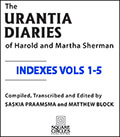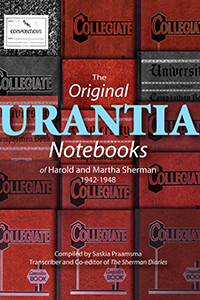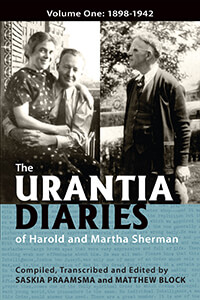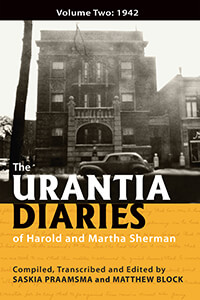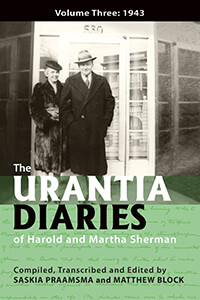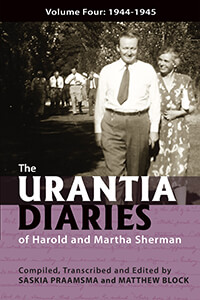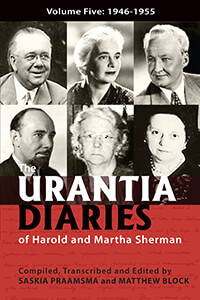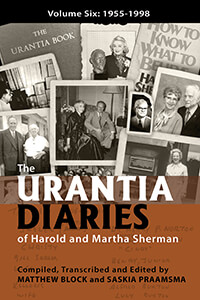The Urantia Diaries

Compiled and Edited by Saskia Praamsma and Matthew Block
In The Urantia Diaries of Harold and Martha Sherman, we present the Shermans’ Urantia-related experiences, as reported by themselves in their letters and diaries.
Harold Morrow Sherman (1898-1987) was born in Traverse City, Michigan, into a middle-class family. He had a multi-faceted career. Starting out as a newspaper reporter and advertising copywriter, he went on to publish hundreds of short stories for boys and dozens of juvenile books. He also wrote six novels, two Broadway plays and two Hollywood screenplays. Deeply idealistic and feeling himself psychically gifted, he authored several bestselling books in the ESP and self-realization fields, some of which are still in print. Early in life he sensed that he had a mission to perform for humanity, a mission somehow connected to his writing, a mission he tried earnestly to discover and actualize as he continued to write.
Harold’s wife, Martha Bain Sherman (1898-1998), was also born and raised in Traverse City. She trained as a nurse but devoted her life to caring for Harold and their two daughters. She was Harold’s confidante and sounding board, sharing his occult and parapsychological interests and collaborating on many of his projects.
Eight years after the Shermans left Chicago in 1947, the Urantia Book was first published. It was, according to unverified stories, the outcome of a mysterious series of events that began when two Chicago physicians, William S. Sadler and his wife Lena K. Sadler, met a man who transmitted messages from higher sources in his sleep. Alluding to the phenomenon in his 1929 book, The Mind at Mischief, Sadler said that the initial encounter occurred in the summer of 1911. He wrote that, in the ensuing eighteen years, he had been “present at probably 250 of the night sessions, many of which have been attended by a stenographer who made voluminous notes,” in which various superhuman personalities spoke through the sleeping man. In an unpublished essay written in 1960, Sadler explained that the communications described the nature of God, the structure and administration of the universe, angelic realms and beings, the afterlife, and other inhabited planets.
Sadler said that a “contact commission,” consisting of those who were present when the man transmitted messages, was formed. Its members were the Sadlers, Lena’s sister Anna, and Anna’s husband, Wilfred C. Kellogg. Later, the Sadlers’ son Bill and their friend Emma L. Christensen joined. Sadler told the Shermans and other Forumites that he invited other physicians and the magician Howard Thurston to observe the sleeping man, but the existence of this man has never been substantiated. No supporting documentation—Sadler’s medical records of the man, the stenographer’s notes of the sessions, or the man’s own handwritten communications—has ever surfaced.
In 1923 Sadler formed a weekly discussion group—the Forum—at his home/
office at 533 Diversey Parkway, made up of his and his wife’s patients and like-minded friends. In 1924 he shared with them some of the mysterious communications and told them that the superhuman beings were willing to answer their philosophical, cosmological and religious questions in connection with a comprehensive revelation they were preparing. Forumites who were interested submitted hundreds of questions, via the contact commission, which led to the appearance of a bulky handwritten manuscript addressing many of those questions, in late 1924. The Forum became a closed, secret group whose function was to listen to and comment on the developing manuscript, and to submit further questions.
By the mid 1930s the higher beings had transmitted a prodigious document of 196 papers, including a highly detailed account of the life and teachings of Jesus. In 1942, the year the Shermans arrived, Sadler announced that the Forum’s function as a question-asking body was terminated. The Forum members still met weekly to listen to Sadler, his son or other Forumites read out and comment on the manuscript.
“The Book of Urantia,” as it was then called, was intended to be published and, as it spread, prove itself to be a major revelation of truth from celestial beings to our world. The superhumans were to give permission for printing when the time was right; until then, the Forum group was to prepare the book for publication and raise money for the plates.
One of the early Forumites, who plays a pivotal role in this series of volumes, was a Chicago policeman and detective named Harry J. Loose. One evening in July 1921, when Loose was in Marion, Indiana, giving a Chautauqua lecture on crime, he was interviewed by Harold Sherman, then a young newspaper reporter. During their brief meeting, Loose dazzled Sherman with his apparent telepathic abilities and mentioned that he, Loose, would be dropping out of sight while on a “mission.” In a letter to Sherman a few weeks later, Loose intimated that Sherman himself was “fitted to a mission of tremendous good and importance to the world.” Soon afterward, Harold and his family moved to New York where Harold became a successful writer and radio personality, as well as a noted ESP experimenter.
In February 1941, Sherman felt impelled to track down Harry Loose and learned that he was living in retirement in Monterey Park, a suburb of Los Angeles, California. The two men began a correspondence in which Loose explained that he and Sherman had a bond spanning many lifetimes, that the two belonged to a special order of beings who incarnated on Earth periodically to perform important missions. He also imparted much information derived from the Urantia material.
Enticed and inspired by Loose’s repeated assertions that a great mission lay in store for him, Harold was anxious to see his mentor again face to face. His desire was realized in May 1941, when a screenwriting assignment brought him to Hollywood. As the men became better acquainted, Harold learned of Loose’s connection to Dr. Sadler and the Urantia phenomenon. He also realized that Sadler was a cousin of an old friend of his and Martha’s--Josephine Davis--from their days in Marion, Indiana, and it was through her that the Shermans were introduced to Sadler and accepted as Forum members during a brief trip to Sadler’s home in Chicago in August 1941.
Even though they had still not seen or read the Urantia text, the couple were so impressed with what they’d heard from Harry Loose that they made plans to move to Chicago to pursue a full-time study of the new teachings as soon as Harold’s screenwriting project was finished. Harold and Sadler also maintained a correspondence in which Harold expressed his ideas about the important role he believed he was destined to play in dramatizing aspects of the revelation to capture public attention.
* * *
Volume One of The Urantia Diaries contains the correspondence Sherman had with Loose, Sadler, Sir Hubert Wilkins and others about the Urantia phenomenon before the Shermans arrived in Chicago in May 1942 and began attending the Forum and keeping the diaries. These letters are just as interesting historically as the diaries, giving a glimpse of how the knowledge of the Urantia text was diffused in these years.
Volume Two, covering May to December 1942, records Harold and Martha Sherman’s first flush of enthusiasm for the Urantia revelation as well as the events that culminated in the first major conflict among Urantia believers. It provides a far more accurate account of this period than the truncated and pseudonymized version Harold gave in the “Pipeline to God” chapter of his 1976 book, How to Know What to Believe.
The volume opens as the Shermans arrive in Chicago and find an apartment directly across the street from the Sadler residence at 533 Diversey Parkway. They renew their acquaintance with Dr. Sadler and his relatives, meet other Forumites, and begin reading the Urantia papers and attending the Sunday Forum meetings. Soon joined by Sir Hubert Wilkins, the renowned polar explorer whom Sadler had admitted to the Forum on Harold’s recommendation, the new Forumites—Harold, Martha and Sir Hubert—are warmly welcomed by the people at 533.
Perhaps due to Sir Hubert’s celebrity and Harold’s recent success in Hollywood, combined with the men’s ardent interest in the Urantia phenomenon, the Shermans and Sir Hubert soon became favored Forumites. They sat at the Sadlers’ table at Forum events, and Sadler and his son Bill took them into special confidence, reading out to them apochryphal accounts of interactions they'd had with superhumans which weren’t included in the Urantia papers. Sadler also gave the Shermans a detailed account of the early years of the Urantia phenomenon, which apparently few Forumites had heard.
At the very time that the Shermans and Sir Hubert (who was only able to come to Chicago for short visits) were engaged in their first reading of the Urantia papers, Sadler announced, at the annual Forum picnic, that the Forum’s long-running role as a question-asking group was ending. Since about 1924, Forum members were invited to submit written questions which might influence the content of the developing Urantia manuscript. That role having been fulfilled as of May 31, 1942, the Forum was to continue studying the papers and to contribute funds for the eventual publication of the Urantia Book. The Sadlers had already formulated organizations—the Urantia Foundation and the Urantia Brotherhood—which would begin to function upon the publication of the book. The Foundation was to have absolute control over the production and translation of the Urantia Book, while the Brotherhood was to be the official membership organization of believers in the Urantia revelation.
But questions were just beginning for Harold and Martha as they read the manuscript and learned of the Sadlers’ publication and organization plans. Indeed, as Volume Two describes, Harold was besieged with questions and concerns. Throughout the late spring and summer of 1942 he shared his concerns and suggestions with the people at 533 and with the Forumites he and Martha had befriended. Not satisfied with the Sadlers’ responses, and encouraged when he learned that other Forumites shared his concerns to one degree or another, Harold helped write a petition, signed by almost fifty Forumites, asking Dr. Sadler to allow free and open discussion of the planned organizations.
Upon receiving the petition, Sadler, who had gotten wind of it beforehand thanks to two anxious Forumites, orchestrated a reaction which, in the course of a few days, succeeded in quashing virtually all sympathy for Harold and his proposals.
In the space of less than a month, the Shermans went from being favored Forum members to being largely shunned. They continued attending meetings for four-and-half more years as quiet observers. Harold shared his plight with a sympathetic Sir Hubert Wilkins, and the Shermans became close to a few Forumites who resisted Sadler’s apparent attempt to ostracize Harold. These few shared their confoundment at Sadler’s actions, which had revealed, to them, an unexpected, dark side to his character.
Throughout all these developments, the Shermans were in frequent correspondence with their mentor, Harry J. Loose, the eccentric retired policeman who had been a member of the Forum until 1934, when he and his wife Emily moved from Chicago to Monterey Park, California.
In addition to other advices, Loose encouraged the Shermans to keep a secret diary to use in a book Harold was to write about the history of the Urantia phenomenon. The Shermans began this diary on July 24, 1942 and maintained it for several years, even after leaving Chicago in 1947. They had also created a “Forum Calendar,” in which they jotted down notes of events which occurred from July 26, 1941 (when Harold was introduced by phone to Sadler) to November 18, 1942. Every entry of the diaries and of the Forum Calendar is included in these volumes.
Volume Three documents a full year of Urantia-related activity as witnessed by Harold and Martha Sherman and described in their diaries and letters. During this year, 1943, the Shermans continue to attend the weekly Forum meetings almost without fail and to record their recollections immediately afterward. Feeling unjustly blamed by Dr. Sadler for the so-called rebellion the previous summer, they share their frustrations with their few friends in the Forum, and confide their growing doubts about the Doctor’s trustworthiness as custodian of the Urantia papers. Their closest confidante remains Harry J. Loose, now in failing health but still providing advice and instruction through long, frequent letters. The year culminates with Loose’s death, which Harold and Martha perceive as opening a new era in their lives. 1943 is also a busy year for Harold career-wise, as he continues his pursuits as author and playwright, and becomes host of his own radio program in Chicago.
In Volume Four Harold and Martha Sherman report their Urantia-related experiences for the years 1944 and 1945. During this period the Forum hears the papers that became Part III of the Urantia Book, and the Shermans record their impressions of each paper as well as their discussions with Forum friends on these and other subjects. Harold is forced to miss a number of Forum meetings while in New York and Hollywood pursuing various book, stage and radio projects, but Martha attends regularly. No longer in the forefront of controversy, the Shermans quietly maintain their criticisms of Dr. Sadler’s handling of the papers. In late 1945 a frank meeting with Harry Loose’s close friend, Reverend Elmer Williams, causes the Shermans to reflect anew on their involvement with the Urantia project, resulting in a turning point of sorts.
Volume Five documents the years 1946 to 1955, spanning Harold and Martha Sherman’s last year and a half as Forumites and the period leading up to the long-awaited publication of the Urantia Book.
In the summer of 1947, their younger daughter having graduated high school, the Shermans decided to move to Arkansas, where they had bought a cottage. Finding little inspiration in the Jesus papers and frustrated by the stalemate in their relationship with the Forum leaders, the Shermans made their last appearance at 533 Diversey Parkway in December of 1947.
With Ark Haven as his home base, Harold continued a busy career as a writer and traveling lecturer. After gaining entree into the New Thought movement as a speaker and teacher in the early 1950s, he became nationally known, but he continually sought to reach the wider public through film, television and radio. During his respites in rural Arkansas, he was active in community development projects, campaigning for paved roads, electrification and tourist attractions. But, as the Cold War developed and the threat of atomic war loomed, and as UFO sightings were gaining international attention, Harold was most concerned with trying to help people realize their “higher powers of mind” so as to forestall disaster and steer the world in a better direction.
During these years the Shermans kept in regular contact with a few Forumites, including Elsie Baumgartner, Rachel Gusler, and Sir Hubert Wilkins. Their letters—touching on matters personal, political, philosophical, and spiritual—provide a glimpse into the concerns and perspectives of members of the first generation of serious students of the Urantia papers. In their travels Harold and/or Martha met or renewed their acquaintance with a number of other Forumites and former Forumites, recording their experiences in letters and diary entries. Further, Harold was instrumental in sparking San Diego businessman Webster Stafford’s enthusiasm for the Urantia papers and other purported revelations. Stafford’s documents, reproduced in the Diaries, represent the first known attempt to appreciate the Urantia papers in the broader context of comparative analysis.
Volume Six covers the years 1955-1987. Through those years Harold Sherman never totally lost touch with the Urantia movement. Throughout the controversies during those years, ousted and disgraced "rebels" such as Robert Burton and Jacques Weiss corresponded with Sherman to present their sides of issues, information that has not surfaced before. And as Sherman's contemporaries passed away new enthusiasts came along to correspond with him, wanting to know all about the history of the revelation which they were not getting from "headquarters," and this is what partly influenced Sherman to write 'Pipeline to God."


